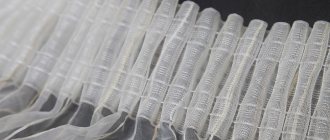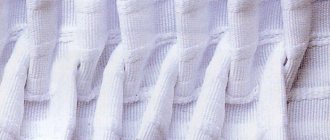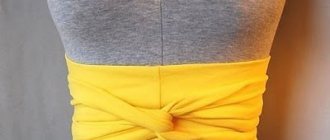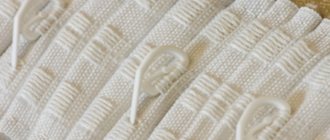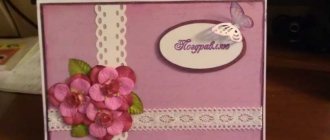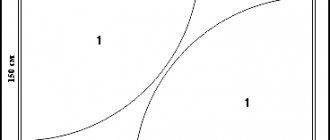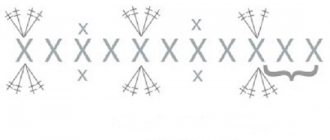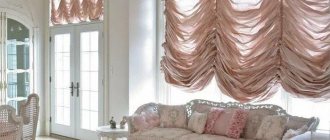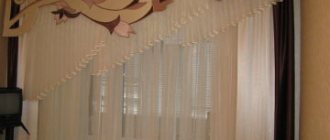Sometimes, we want to update and decorate a boring interior, but not to destroy the whole house in pursuit of major alterations. Of course, you need to strive for changes, but let them not be grandiose, because in the future you will again want novelty and experiments.
You can change the interior of a room quickly and easily; you just need to decorate the window opening. The main purpose of curtains is protection from sunlight, sound waves, drafts, wind; they also play a decorative and individual role, reflecting the taste preferences of the owners.
voile curtains
Floral pattern - trend of the 2018 season
If you can’t find a suitable model or you don’t like the curtain options that are presented in the store, then try sewing curtains with your own hands.
As shown in the photo, voile curtains are used not only in window textiles, but also when decorating doorways
The sewing process itself is elementary.
Any housewife who has already learned the art of needlework can sew beautiful curtains with her own hands. To do this, you only need desire and a little free time. Sewing curtains can be divided into several stages.
Preparation
The first thing you need to start with is searching for a curtain model and measuring the window. Think about what kind of curtains you like and whether they are suitable for this room.
Voile curtains with flowers - fits perfectly into the kitchen interior
After this, decide on the following nuances:
- model;fabric;shade;style;ornament.
Go shopping to explore models and all kinds of shades of curtains, look at new products, evaluate designs and study ready-made curtain options.
As a result, you will make the right choice and find something for your product. If you don’t have time to go shopping, you can use magazines to save time and effort. Next, proceed to choosing a wall or ceiling cornice; give preference to the one that will more effectively complement the style of the room.
For curtains with a veil, designers recommend using wooden curtain rods
It's time to take measurements of the window frame.
Since the future curtain pattern will be based on its data. After measuring all the indicators of the window, calculate the required amount of material. Remember that if, for example, you are sewing a bandeau lambrequin, the width of the fabric should match the length of the cornice, and the length should match the distance from the ceiling to the floor.
Tip four
Don’t be lazy to smooth out future seams and smooth out finished ones. It doesn’t take much time, but you will avoid many problems later.
Sweep it away. We stitch it. We remove the basting. Ironing.
The next step is to sew on the curtain tape.
I purchased a wide curtain ribbon that forms bow pleats.
Before you start sewing the curtain tape, you need to measure the required height of our curtains and mark it, for example, with a pencil. I did not cut off the excess fabric, but simply folded it. On top I ended up with this kind of improvised shuttlecock. In order to evenly fold the excess fabric, you need to use a measuring tape, or, like me, a small tape measure.
We measure the hem to the required length and iron it along the entire length of the veil. Now you can baste the curtain tape.
We baste on both sides, top and bottom.
Pattern
To sew any item, an experienced craftsman knows that it is first necessary to create a pattern.
Otherwise, you risk ruining the item. The template directly depends on the measurements of the window opening and the curtain model you choose. Most novice needlewomen do not know how to make a sketch on their own, but this is not a serious obstacle when sewing curtains.
Ask a seamstress you know for help or find on the Internet an example of the required curtain model with comments on its construction. Transfer all measurements to A4 sheet. Many seamstresses recommend using unnecessary rolled wallpaper as paper, but I recommend reflecting a small copy on a blank sheet of paper, and then, when transferring the template to the fabric, measure out the required dimensions.
Sewing
The first thing to do is to cut the curtains; to do this, transfer all the measurements to the fabric, leaving allowances for the seams. Markings can be applied using chalk or soap. Next, cut the necessary parts and process the ends of the curtain (iron).
Then baste the stitches by hand and if you are satisfied with the appearance of the curtains, then you can sew them together. Using a sewing machine, stitch all sides of the curtains. Sew a ribbon with loops to the top edge, and finish the bottom side using a thin thread.
Although the veil material is not complicated, the stitches still need to be done carefully and slowly
Remove the basting and the bulk of the work is done.
Advice: don’t forget to sew the parts together; if you miss a small detail, you can ruin expensive fabric and waste time.
Therefore, it is very important to pay special attention to fabric with various elements: colors, lines, geometric shapes. When arranging the fabric while cutting, make sure the patterns match exactly. Also, for beginners, it is better to immediately take several meters of additional fabric.
Tip five
Before sewing the curtain tape on the sewing machine, hang the basted veil on the curtain and see if the length suits you. To be honest, I had to reduce the height of the curtains again, I was deceived by a few centimeters. Moreover, in order to try it on the window, I basted only about a meter of curtain tape to the veil on both sides. This is enough to understand whether we have folded our curtains correctly.
Trying on the window. Then we attach the curtain tape (also at the top and bottom) using a sewing machine.
The next stage is to iron our veil well along its entire length.
Now we can tighten the curtain tape, and therefore our veil, to the desired width.
We tighten and immediately put on the hooks.
We hang the veil on the curtain.
In my opinion it turned out not bad! A solid four.
Decoration
Properly selected accessories and decor will help complement and improve your product. If your room is designed in a minimalist style, then unnecessary decorations will simply be inappropriate here.
Voile curtains themselves in such an interior will look laconic and have a complete look
However, if you still decide to decorate your curtains, then use:
- all kinds of tiebacks; magnetic decorations; chains, rings; cords and braid made of fabric; ribbons in the form of flowers; bows and tassels.
To make decorative parts with your own hands, you can use various elements: beads, flowers, shells, decorative threads, etc.
Don’t be afraid to be original and use the most unusual materials to create accessories; perhaps you will find a solution that will complement the entire interior of the room and thereby highlight your creative personality.
Veil lambrequins
If you have enough fabric left, you can sew a beautiful accessory for curtains with your own hands - a lambrequin. A soft lambrequin made from a veil will complement the overall picture of the window frame, the only thing is that it needs to be diluted with additional decorative elements or another ton of fabric. This is necessary so that the image is not pale and monochromatic. The pliability of the fabric will make it easy to create an original and beautiful addition to the interior in any style.
This unusual shade of curtains with a lambrequin is ideal for rooms decorated in light, soothing colors - the photo is a clear confirmation of this
Options for lambrequins made from a delicate veil:
First option.
A simple lambrequin falling in waves will be a romantic decoration for a bright and spacious room. Second option. A lambrequin of complex shape, with various: throws, luxurious trains to the floor itself. This richly colored veil accessory will become an organic element and complement the interior of any kitchen.
- Date: 03/27/2015 Comments: Rating: 11
Any, even the most thoughtful and expensive interior will look imperfect without a decent window frame. It is curtains that bring comfort and charm to a room, especially when it comes to textile accessories made from light, flowing fabric. Weightless voile curtains are an excellent solution, especially since you can sew them yourself, thereby making the interior individual.
The veil is a beautiful and delicate material; simple patterns can be used to sew it.
Voile is a translucent curtain fabric, usually used for sewing light curtains. It is distinguished by its weightlessness and special transparency, which create a hazy effect. This material drapes beautifully and goes well with thick curtain fabrics. It has features that must be taken into account when working with this fabric; recommendations from specialists and designers will help to provide for all the nuances.
Description of voile curtains
The popularity of the veil is due to its beautiful appearance. This is a translucent, airy, delicate material that is pleasant to the touch. The texture of voile curtain fabric is similar to a fine mesh net. Regardless of the composition, veils include all thin, transparent materials obtained by plain weaving.
The ancient Egyptians used finely woven linen to make voile fabric. In Western European countries, before the advent of synthetics, it was made from cotton, wool or silk fibers. Nowadays the veil is obtained by weaving and connecting threads of natural and artificial origin.
Unlike organza, the veil has a dense structure and a special soft texture. As a result, as can be seen from the photo of voile curtains, they can be attached to the cornice using:
- Curtain tape.
- Kuliski.
- Clamps and clips.
- Loop.
- Magnitov.
When working with a veil, important importance is given to the correct selection of the cornice. Voile curtains look wonderful with a wall profile or ceiling cornice structure, especially if the window opening has a complex configuration.
For light curtains, it would be appropriate to use a telescopic type of cornice or a variation made from an alloy of polymer and metal.
The lightest veil in the interior
Voile is a specific fabric that fascinates with its lightness, tenderness and seeming fragility.
Window accessories using it always look gentle and charming. And a special advantage of the material is the ease of working with it. Voile curtains should not have a complex shape; the apparent simplicity is compensated by the lightness and weightlessness of the material.
A light veil can be used to decorate any room, but you need to take into account the features of the room:
Voile curtains in the living room interior should be in harmony with the decor of this room both in color and pattern.
A simple, weightless curtain that can be moved and secured at any time with an original pin will look great in the kitchen. For an actively used kitchen, it is better to stay at the length up to the window sill. The peculiarity of the veil is that it looks most successful in thick drapery. You can also use a veil to decorate a nursery, but it is worth considering that active kids can easily damage the weightless material.
To ensure that window decor retains its beauty for as long as possible, you should choose curtains of simple shapes, compensating for this feature with color and original accessories. For the bedroom and living room, voile curtains are the ideal solution. They will make the room cozy and charming, setting you up for relaxation and a pleasant pastime. If flowing fabric seems rustic for window decoration, it can be complemented with a rigid lambrequin or catchy tie-backs, creating the perfect ensemble that matches the taste of the household.
Return to contents
The veil is a self-sufficient material that looks stylish and original even without flashy additions.
The main condition for presentability: sufficient width of the canvas - from double the length of the cornice or more. In this case, the thick coattails will already act as decoration. What kind of veil curtains can you create with your own hands?
Option for patterning curtains from a veil.
A play of layers and shades. Layering a thin veil of different colors looks stylish and original. To make the curtain look perfect, you need to select shades from the same color range.
For example, the main curtain is white, the second is beige and the third, narrowest, is a cocoa shade. Sewing such curtains comes down to proper edge processing and color selection. Radiant simplicity. Curtains made of voile with golden thread look catchy and at the same time stylish.
This material is completely self-sufficient and does not require additional decorations; any light source turns such a curtain into a masterpiece. Just move 2 sheets of shiny voile to the sides and secure them with tiebacks - the original curtain is ready. All attention to the accessories. The veil, due to its simplicity, rarely looks bright enough and is not capable of becoming a stylistic accent.
If your soul gravitates towards catchy window decorations, it makes sense to decorate the curtain. Beads of various types, shimmering crystals, and lace are perfectly combined with weightless materials. Even a rough cord can become an accent, as it will emphasize the delicacy of the fabric. Delicate lambrequin.
Lambrequin, as an element of window design, does not lose popularity. Although veil does not seem like a suitable material for sewing it, anything is possible. A lambrequin made of weightless fabric looks gentle and fresh, it fills the room with charm.
Sewing such a decorative element is quite simple. It is enough to properly process all the edges, secure the center of the fabric cut to a cornice or board and give free rein to your creativity. By throwing lightweight material over the cornice, pinning it with pins and adding flashy accessories, you can get a completely unique veil lambrequin.
Return to contents
Veil curtains in the kitchen can be sewn in bright colors, but minimalism should prevail in the cut.
So, the image of the future veil curtain is ready, all that remains is to purchase the material and sew the window decoration.
You need to choose fabric based only on your preferences. But in matters of tailoring, it is better to listen to the advice of experts. And it’s better to learn all the subtleties before the time comes to go for the desired cut.
First of all, you need to decide on the model of curtains. It is better to draw a sketch, indicating the width of the ceilings, the depth of the folds and noting color nuances if more than 1 shade is used.
Then carefully measure the window opening.
This is important to do in advance, since even the most original voile curtain looks foreign if it is the wrong size. After these two stages, you need to compare the data and determine the required fabric footage. It is important not to forget to take into account the presence of a pattern if there are 2 or more curtains.
You also need to purchase auxiliary elements. This includes curtain braid, bias tape, and threads of suitable thickness and color.
Once everything is purchased, you can start working. To sew voile curtains, you will need:
- sewing machine; scissors, needles, threads, pins; ruler; iron; curtain tape.
Knitting pattern for voile curtains.
First of all, you need to sew on the braid; its length corresponds to the width of the curtain.
This is done using the double fold method. That is, the top edge of the veil must be folded 2 times, each fold corresponds to the width of the curtain tape. After this, secure the element with pins or iron it with a not too hot iron.
Sew the braid in 2 lines: along the top and bottom edges. If this element is wide enough, you need to make a stitch at each thread for tightening. Under no circumstances should the edges of these threads get caught in the stitching.
If the bottom and side sections are not processed, they can be hemmed using the same method. It is enough to make a narrow double hem and lay a neat seam.
It is important to take into account that the veil is a thin and light fabric, so that it lies beautifully, it is worth weighing down the lower edge. The easiest way to do this is to contact a specialist. Additional weighting edges are often made at the point of sale.
It’s not difficult to sew curtains from a weightless veil yourself. The main thing is to think through the design of the curtain and carefully process the cuts. And the most delicate material will do the rest itself, turning an ordinary room into a charming corner of comfort.
It has long ceased to be a secret that the windows in our premises play not only the role of a source of natural light - they are also an integral part of our interior and the overall feeling of harmony, peace and comfort depends on how correctly we decorate them in the room.
Learning to sew curtains from a voile
Just look at the photos below, which clearly show how easily curtains can either ruin a designer’s entire idea or, on the contrary, give it additional charm and grace. So, for example, if you want to achieve additional lightness and airiness, then for a transparent curtain you can choose a material that is popular today - a veil. By the way, in this article we want to tell you how to sew curtains from a veil with your own hands.
Unusual curtains
The process of making unusual curtains from discs.
You can go further and use original materials to make curtains with your own hands. A catchy window frame will literally transform the room.
To make a ribbon curtain, you only need ribbons and beads. The upper part must be secured to a cornice or plank. After this, thread the ribbon through the beads and fix the decor at the desired height by simply tying a knot. This curtain looks original and stylish.
You can give a second life to memorabilia that previously had no worthy use. These could be shells brought from the shores of the gentle sea, old pearl beads and other elements of a marine theme. You can use them to make gorgeous curtains with your own hands. Additionally, you only need fishing line and sharp scissors.
First of all, you need to prepare the shells. Soak them and clean them of organic residues. To achieve a snow-white color, seafood must be soaked in a bleach solution. After this, carefully make a hole using sharp nail scissors. Next you need to prepare the base - cut the fishing line. Then you can start stringing shells and pearls one by one. After each element you need to tie a knot; it will not allow the decor to shift and disrupt the harmony of the sea mood.
The pattern of working with shells can be used to create curtains from any decorative items. This can be beads, beads, wooden figures, silhouettes of butterflies or flowers cut out of plastic, crocheted snowflakes and even unnecessary CDs. The main thing is to choose the right theme for the curtain; it is important that it complements the interior or harmoniously solos in it.
Thread curtains also open up limitless scope for creativity for the hostess. It is enough to attach them to a cornice or base plank and you can use your imagination. The threads can be supplemented with original tiebacks or pins, tied in a knot, or even woven into stylish braids.
Decorating your home is a great way to fill your interior with coziness and charm. Sewing or making curtains with your own hands is not at all difficult, but such a design element will allow you to demonstrate to guests, household members and, of course, yourself that talent in tandem with skill can work wonders.
What is important to know before you start working?
The very first stage is to understand for what specific room you want to sew voile curtains and what they should look like:
- if you decide to transform a window in the kitchen, then it is better to choose a simple, even shape, without any frills; if you plan to give a new look to a window in a child’s room, then the colors should be cheerful, cheerful, bright, but without curvaceous shapes; In the bedroom or living room, you can already play with different shapes, decor and other additional accessories.
But in any case, the window design must correspond to the overall design of the room. And the process of sewing curtains with your own hands from such a delicate material as a veil can be quickly mastered thanks to the presence of photo and video instructions. Also, in this article we will present a master class that will definitely help you sew the desired curtain.
What is a veil: composition and method of fabric production
Most voile fabrics are made by weaving very fine polyester threads. The result is an inexpensive, almost weightless canvas. Less commonly, you can find a veil made by weaving natural silk or wool fibers. This variety is considered elite and is very expensive.
The main advantages of voile curtains include:
- good ability to transmit sunlight;
- the ability to diffuse and not let bright daylight into the room;
- wide range of window design options;
- ease of care;
- low cost.
Let's get started
It would be ideal if, just before starting work, you draw a sketch of the curtain that you are planning to sew yourself. If the product is multi-colored, then be sure to indicate every detail in this sketch - in accordance with this, you will purchase the veil. After that:
- Remove all necessary dimensions from the window opening. Please note that if you want the fabric of the finished product to lie slightly on the floor, then add from twenty-five to thirty centimeters to the resulting measurement.
- Now lay the fabric right side up and align all the edges. If you have chosen a fabric with a pattern and are going to sew not one curtain on the window, but two, then make sure that your pattern matches completely. Carefully hem the bottom part of the fabric using a thin thread. And attach a ribbon with hooks or rings to the top edge, with which you will attach the finished product to the cornice.
By the way, according to the photo instructions and advice in it, it is better to attach the veil, or rather the curtains made from it, to a wooden cornice. The master class presented here demonstrated how you can create a curtain for a room decorated in the Art Nouveau style with your own hands.
Important points
Before you start sewing voile curtains, you need to decide on the design. It all depends on the functional purpose of the room for which they are intended:
- for the kitchen, curtains of the simplest cut are best; minimalism here will be absolutely appropriate from both an aesthetic and functional point of view;
- for a nursery it is better to sew curtains that are cheerful and bright, but it is better not to get carried away with curvaceous shapes;
- in the living room, as well as in the bedroom, the design of curtains should be carefully thought out, because it should be in harmony with the overall design of the interior and emphasize it favorably. Here, as an elegant addition to classic voile curtains, you can also create, for example, lambrequins.
If you are not sure whether you can sew complex curtains correctly, it is better to limit yourself to the simplest model. A delicate and beautiful veil completely compensates for the simplicity of the cut, and your curtains will still look very elegant. To add brightness to the interior, you can use, for example, materials in contrasting colors.
Stages of work
Before you sew curtains, you need to think about exactly how they will look. Draw a sketch, indicating each detail on it, purchase voile fabric of the desired color. Of course, the easiest way to sew ordinary straight curtains with your own hands, for which you don’t even need patterns. Following the photo instructions, do the work step by step:
- take measurements of the height and width of the window opening, calculate the required amount of material. If you want the curtains to lie a little on the floor, take fabrics 25-30 centimeters larger;
- Place the fabric right side up and align the edges. If you are using a patterned voile and are going to sew two curtains, make sure that the pattern matches;
- hem the panel from below using a thin thread;
- Sew a ribbon with loops to the top edge, with which the curtain will subsequently be attached to the cornice.
Let's add some decorative elements
When you have already hung your curtains on the window, it’s time to think about whether it’s worth additionally decorating the veil or whether its severity and laconicism is quite enough for the interior style in which your room is decorated. Decorations, or in other words, decor, can also be made with your own hands. The following are quite suitable for these purposes:
- chains from old bags, for example; various types of fabric cords; beads or whole beads; all kinds of ribbons, different in width and color; bows and so on.
As you can see, the veil from which you made your own new curtains allows for the proximity of various materials.
Tip three
In order to evenly cut thick fabric, you need to cut the edge, take one of the threads and gradually pull it out of the fabric. You will see a light strip along which you cut the fabric. The cut is perfectly straight. The veil is simply cut and torn like gauze.
Before you start basting the edges (basting is required, without it everything will go wrong), the material must be smoothed along the edges, since the edge of a veil begins to curl when the fabric tears. An iron is simply an irreplaceable assistant when sewing curtains.
Then you can start basting the side seams. I did without an iron here. Folds the fabric in a double hem, approximately 1 cm wide. Sew using a sewing machine (when sewing, we stretch the fabric a little, then there will be less “struggle” on the seam. Any seam tightens the fabric a little, even if the machine is well adjusted). Then we remove the basting.
Neighborhood with curtains
We devoted the entire text written above exclusively to one material - the veil.
But this does not mean at all that the curtain from it must necessarily perform a solo number. These curtains can easily be combined with heavy curtains, which can even enhance the effect of such a delicate and airy material as a veil in certain interior styles. Therefore, dear and respected craftswomen, do not be afraid to experiment and create more and more new masterpieces on your own, without turning to various salons for help.
Summarize
Most of us, if not all, would agree with the opinion that monotony is boring. And first of all, we may get tired of the interior around us. But it’s unlikely that anyone would want to redo renovations every year, changing styles.
And in this case, an excellent solution would be to “update” the appearance of our windows and change their design. In addition, sewing new “clothes” for them, as it turned out, is not so difficult and is quite possible even for novice craftswomen and housewives. We sincerely wish you good luck in all your endeavors!
Similar articles
Comments
Long gone are the days when the haberdashery stores of the vast union unanimously offered only seven options for tulle: with three flowers, with two types of ornaments, dense in small or large tied holes, which we so loved to pick with our fingers.
Today, an abundance of fabrics is offered to us not only by shops and markets, but also by countless online stores that promise to deliver goods from the other side of the world. The colors and textures make up voluminous catalogues, rivaling Tolstoy's War and Peace in thickness.
Types of veil
Often, window design includes two main elements: thick curtains and loose fabric (for example, tulle veil). The purpose of dense fabric is to cut off excess light entering the room and prevent people from viewing what is happening in the apartment from the street at night. A loose fabric (tulle voile) serves to diffuse incoming light and drape the window from the inside to create a unique mood in the room.
Tulle (large weave of threads) is used as a loose curtain; veil is a medium weave of threads or organza (fine weave). The threads for them can be either natural (cotton, silk, wool) or artificial (Lurex, lycra, etc.).
Today we will look at the veil, since it has a denser texture compared to tulle and softer than organza.
Today you can find a veil: Regular weave. Micro-veil or semi-organza. You can distinguish one from the other by touch. In terms of weaving, micro-veil is close to organza, that is, in fact, it is the sister of the veil, but softer and drapes more easily. According to the finishing, the veil can be: Plain or veil with a pattern (with a gradient). Today you can choose the color of tulle to match any color scheme of the interior.
If desired, you can choose a fabric with a color transition, which will create a special soft atmosphere in the house. With embroidery. If a plain fabric seems too simple to you, then various types of embroidery on the veil are at your service. From light stitching along the edge to full filling using both fancy and floral motifs. With a printed design. If the landscape outside the window is not particularly pleasing, you can choose a material with a printed pattern. Nowadays it is popular to paint landscapes (sea, mountains, forest or famous cities of the world). With a flat bottom or with a shaped edge.
You can decorate the window either with evenly flowing material or with fabric gathered into a drawstring or lambrequin. In this case, the bottom edge will be exposed, and it is very fortunate that there are materials with an edge that is elegantly decorated with embroidery or a carved edge.
Voile tulle for decorating different rooms
Living room.
When decorating a living room, a veil on the windows can either play in unison with the color scheme of the interior, or create a color accent as opposed to a monochromatic room. The living room allows for the presence of symmetrical or asymmetrical draperies and lambrequins. Due to the lightness of the material, the veil can be picked up even with simple Velcro. Bedroom.
As a rule, the colors chosen for bedroom decoration are restrained and pastel. And the task of the fabrics on the window is to darken the space, cutting off excess light. The use of a gradient color of the veil, with a soft transition between colors, looks very advantageous.
The veil itself is light, but quite durable, and can easily withstand decoration with small fabric flowers or crystals if you are a fan of Feng Shui.Children's room. The psyche of children is easily excited. Therefore, when decorating a children's room, it is important to combine bright, cheerful colors with pastel and soothing ones.
Nowadays, different designs of veils are available with a wide variety of colors and patterns, which allows you to decorate your windows with your favorite cartoon characters or characters from your favorite book.Kitchen. Any housewife knows that even when using a hood, cooking grease will settle on all surfaces, including fabrics. In addition, windows in kitchens are often smaller than in other rooms.
All this brings us to the idea that kitchen drapery can be laconic. In this case, such a fabric fits perfectly - soft folds will not overload the impression of the room, and the transparent texture diffuses light, creating homeliness. Interior drapery. The veil, due to its diversity, is suitable for decorating not only windows, but also niches in the interior, bed, or even as a dividing partition between zones of the same room.
If there is a lot of furniture in the room, then some of the cabinets can be curtained, for example, with a gray veil laid in vertical folds. This will not only diversify the interior, eliminating yet another door, but will also visually make the walls taller due to the small vertical pleats. Often, the veil is used to drape children's cradles, thus cutting off not only excess light, but also extraneous noise that can frighten the baby.
Advantages and disadvantages
The veil has the following advantages:
- Light transmission and soft texture make it possible to form beautiful folds.
- Variety of colors.
- Such curtains can be decorated with embroidery, guipure inserts, etching, and appliqué.
- The use of multi-layer voile curtains allows you to bring your wildest ideas to life.
- Affordability.
- Versatility.
- Ease of use.
- Weightlessness and smoothness.
- Visual expansion of space.
- Easy to replace.
Disadvantages include:
- Loss of original color over time.
- The veil collects dust well.
- It's quite difficult to get rid of greasy stains.
How to sew curtains from a veil with your own hands
Curtains are usually rectangular, and therefore they are not difficult to sew. So, you looked through a mountain of options, drew some of the most attractive ones for your room. Now you can go to a store or specialized curtain salon.
Most of them offer services such as partial design of the fabric (hemming and hemming, sewing on braid) or complete tailoring of turnkey curtains. In this case, it is possible for a specialist to come to your home. The master will measure all the necessary parameters of the window, discuss the selected sketch with you and help you decide on a veil that will perfectly embody your design plan.
But if the easy way is not our choice, then we can sew it ourselves. To do this, we measure the window opening, taking into account that the veil will lie in folds.
If you want light folds, make a small allowance for the fabric. If you need tight folds or voluminous drapery, you can safely take three measurements of the window width. Take the length taking into account the hem and, if you do it, the lambrequin.
To mark, you will need a large table or a flat floor. Mark the fabric with soap or chalk, depending on what will be visible on your material color. Don't worry - both wash off perfectly and won't leave any traces.
Stock up on sewing pins, the ones that look like carnations. Please note that the pins, thread, and needle with which you will hem should be as thin as possible.
Then if the first time you don’t guess the location of the hem, the holes won’t stand out much. Baste the seams with one thread and try them on the window. Often the veil “leads” in one direction or another when hemming - after all, it is difficult to draw a straight line on a large panel. If you have an excellent eye and the edges are smooth, lie the way you like and are pleasing to the eye, feel free to attach them.
How to shorten tulle - method 2
It happens that the finished tulle has a weighting material sewn on the bottom that you want to leave. Then you can shorten it by cutting off the excess length at the top.
First of all, you should know the length of the finished tulle. As a rule (for ceiling cornices), this is the length from the bottom of the hook inserted into the cornice to the floor minus 1 cm, but not necessarily. In any case, using a tape measure on the tulle laid out on the floor, you need to set the desired length from the bottom and put a control pin.
Similar to the control marks on the bottom of the tulle (method 1), pins must be placed along the top.
According to the marks, you need to iron the seam allowance towards the wrong side of the tulle, and remove the pins.
https://www.youtube.com/watch?v=s_BqlHllgFg
First of all, you should know the length of the finished tulle. As a rule (for ceiling cornices), this is the length from the bottom of the hook inserted into the cornice to the floor minus 1 cm, but not necessarily.
Then you need to measure the width of the curtain tape that you plan to sew on. You need to add 1 cm to its width, multiply this amount by 2 - this will be the amount of allowance for processing. It is to this figure that you need to cut the allowance along the top of the tulle.
Then you need to measure the width of the curtain tape that you plan to sew on. You need to add 1 cm to its width, multiply this amount by 2 - this will be the amount of allowance for processing.
The trimmed allowance should be ironed to half the width, having previously secured it with pins.
Then you need to measure the width of the curtain tape that you plan to sew on. You need to add 1 cm to its width, multiply this amount by 2 - this will be the amount of allowance for processing.
Then you need to measure the width of the curtain tape that you plan to sew on. You need to add 1 cm to its width, multiply this amount by 2 - this will be the amount of allowance for processing.
After this, all that remains is to insert the hooks into the loops of the tape, and the finished tulle can be hung on the window.
It doesn’t always turn out that the finished curtains correspond to the desired length, and sometimes there is a desire or even a need to sew curtains from the fabric you like yourself. How to hem tulle at home, process the top and edges so that the curtains look beautiful and elegant?
“There’s nothing particularly difficult about this kind of work.” To hem your own curtains, you will need a sewing machine, a minimum set of materials and tools: scissors, needles, threads. Also, keep an iron nearby while you work - you will use it to press seams and hems after each line.
